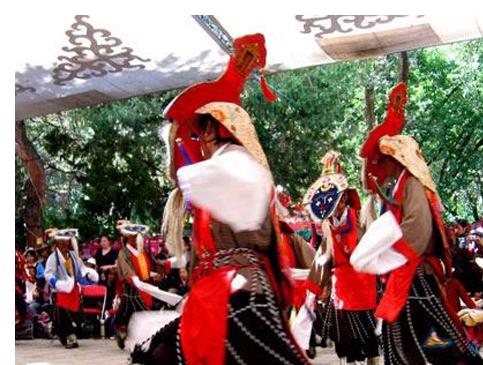
Although not having the fixed tradition, Tibetan play costumes suitcases are diverse and colorful, and carry distinct national styles and features of the snow-covered plateau.
The blue-mask Tibetan play costumes, like Tibetan costumes, feature loose waist, long sleeves and tilted front, have arm(s) uncovered, use gorgeous and strong colors, emphasizes combination of patterns, and are adorned with animal skin, gold and silver, jewelry, ivory and gem. These features determine the use of supplementary attire. For example, a loose run-down robe requires a waistband otherwise one cannot walk easily. Meanwhile, the waistband is a major place to which various ornaments are tied, such as waist ornaments decorated with gems tied about the waist and hanging above the hips. Tibetan play costumes developed from Tibetan costumes of the Tubo period and absorbed the forms of Mongolian costumes of the Yuan Dynasty and official uniforms of the Qing Dynasty in history. The costumes in Qamdo and Dege Tibetan plays absorbed elements from costumes in plays of the Han nationality. The costumes in Menba Tibetan play are largely based on daily costumes of the Menba nationality, and carries obvious influences of the Tibetan costumes.
Tibetan play is closely related to religion in its birth, forming and development. Most plays are stories about Sakyamuni and biographies of eminent monks and saints, so the costumes are loaded with religious elements. Take the blue-mask Tibetan play as an example. Although most stories are from India, none of the costumes are complete Indian. All are costumes of local Tibetans of all ranks. Costumes of other nationalities are also used for some special characters. For example, in Baima Wenba, the Islamic king Mudijiebu wears costumes of the Hui Nationality; in Su Ji Ni Ma, the Han boatman wears costumes of the Han nationality in the Qing dynasty. In formal Tibetan play performances, the Tibetan costumes are mostly costumes of dBus, and a few are costumes of other places. For example, in Zhuowa Sangmu, Si-mo-lang-guo, maid of the venomous concubine Hajiang wears costumes of gTsang; in Suji Nima, the dancer Ya-ma-geng-di wears costumes of the Gongbu clan. The costumes of these characters have nothing to do with the plot, but adjust and enrich the plays. These costumes are gorgeous, colorful and dignified, and features strong color contrast.
Tibetan costumes are mainly made of silk and Tibetan woolen cloth, such as silk, satin, crepe, woolen cloth and pulu. A traditional Tibetan play costume is made of genuine gold and silver silk ribbons and brocades of varied patterns mingled with woolen needlepoint tapestry, gold embroidery, gold-and-thread embroidery and silver-and-thread embroidery, so it is nothing new that such a costume would cost a huge amount of money.
The Tibetan play costumes are normally purchased by the headman of the tribe to which a folk troupe belongs or the temple which the troupe depends on. Every year during the stipulated festival, the troupe would borrow the costumes and then return them back after the performances. There are occasions that a few noblemen, officials and eminent monks sponsor a folk troupe to buy costumes, and occasions that villagers and monks donate money to a village/temple troupe for purchasing costumes. The costumes are made by famous tailors from various parts of Tibet. For example, troupes in the major cities and towns like Lhasa, Xigaze, Qamdo and Zetang invite distinguished tailors that specially sew clothes for eminent monks and local officials to make costumes for them. In long-term practice, these tailors have grasped stunts of matching, cutting, appliqué decoration and embroidery, etc. A number of experienced tailors of Tibetan play costumes with consummate skill emerged, such as Baizhangla and Donggala in Tibet.





